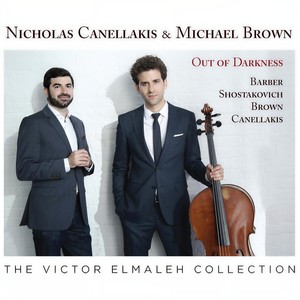
Out of Darkness
- 流派:Classical 古典
- 语种:英语
- 发行时间:2016-08-01
- 类型:录音室专辑
- 歌曲
- 时长
-
S. Barber: Sonata for Cello and Piano, Op. 6
-
D. Shostakovich: Sonata for Cello and Piano in D Minor, Op. 40
-
M. Brown
-
N. Canellakis: Bulgarian Folk Tune
简介
Samuel Barber: Sonata for Cello and Piano, Op. 6 (1932) Samuel Barber wrote his cello sonata in 1932, while still a student at the Curtis Institute of Music. He dedicated it to his composition teacher, Rosario Scalero, but the work reflected significant input from cellist Orlando Cole, a colleague and classmate of Barber’s. Cole premiered the work with Barber in 1933. It is a lyrical and heartfelt work, full of dark-hued romanticism and a palpable sense of American identity. The Barber cello sonata is a very personal work for me, as I worked on it extensively with Orlando Cole, my teacher at the Curtis Institute. It was an incredible experience for me as a seventeen-year-old to explore this work with the cellist who premiered the sonata over seventy years before! Mr. Cole repeatedly told me he worked on the sonata “page by page” as it was being written, and stressed a bold sound with grand, romantic gestures to bring out the rhapsodic nature of the music. - Nicholas Canellakis Dmitri Shostakovich: Sonata for Cello and Piano in D Minor, Op. 40 (1934) Dmitri Shostakovich composed the Sonata for Cello and Piano in 1934, a few months after the original version of his controversial Lady Macbeth of Mtsensk was produced in Leningrad. It was a turbulent period for Shostakovich, as he had an affair with a young student and briefly divorced his wife Nina. It was during their period of separation that he wrote the cello sonata, dedicating it to his close friend, Viktor Kubatsky, cellist of the Stradivarius Quartet and the Bolshoi Theater. Kubatsky and Shostakovich gave the first performance of the cello sonata alongside the cello sonatas of Grieg and Rachmaninoff in 1934. Cast in four movements, the work combines conventional forms with Shostakovich’s unique musical language. The first movement is set in a classical sonata-form structure with a twist; the entire recapitulation is slowed to less than half the tempo of the movement, dissolving into a chilling and bleak march. The second movement is a high-octane scherzo with a propulsive, manic energy. The dark, introspective slow movement that follows is perhaps the most vulnerable and heartfelt part of the work. He paints a reflective and icy canvas, full of lingering dissonances and contemplative melodies. After the quietly powerful coda, one gets the feeling that Shostakovich has completely bared his soul. The brief and sarcastic final movement, with echoes of rondo-form, jolts the music out of the dark mood into the world of black comedy. With episodes of virtuosity for both instruments, including a brilliantly wild passage of scales in the piano part (apparently evoking his student days in the Moscow Conservatory walking around the halls listening to people practicing), the work comes to a dramatic close. - Michael Brown Five A.M. “after Allen Ginsberg” (2009) Five A.M. for cello and piano is based on a succinct poem of the same name by Allen Ginsberg. I was instantly struck by the poem’s restless and manic quality, with the speaker ranting about life’s unanswerable questions in a seemingly drug-induced state of existential crisis. The poem depicts the anxious thoughts that can keep one awake at that transitional time, when night shifts into morning. With my Five A.M., I do not attempt to match up the poem word for word with the music, but rather depict its essence as I perceive it. My work is in two contrasting sections (slow-fast), to be played without a pause. Quick shifts in mood and character create a manic atmosphere, with lyrical gestures intermingling with jagged, emotional outbursts. Composed in 2009, the piece is dedicated to cellists Nicholas Canellakis and Gal Nyska and received its world premiere at The Juilliard School. - Michael Brown Bulgarian Folk Tunes, arr. Nicholas Canellakis Gankino Horo and Daichovo Horo are traditional Bulgarian folk dances employing irregular beat patterns. Gankino has 11 beats per bar divided as 2+2+3+2+2; Daichovo has 9 divided as 2+2+2+3. While the melodies from these dances are well-known among Balkan folk bands, significant liberties are taken in how the tunes are arranged, making each version unique. In my arrangements, I have taken the basic tunes and harmonies from these dances and created two virtuoso showpieces for cello and piano. - Nicholas Canellakis

